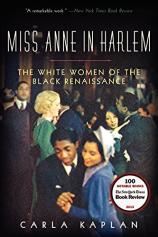Miss Anne in Harlem: The White Women of the Black Renaissance
Review
Miss Anne in Harlem: The White Women of the Black Renaissance
In the 1920s and ’30s, something was bubbling up and out of Harlem; never before or since did that little neighborhood of New York City enjoy such renown. A small number of white women, social activists in their separate ways and known in the black culture of the day as “Miss Annes,” found their way to Harlem in that era: “Part of what Miss Anne’s stories can teach us is that antiracism can also be ordinary, found in some of the most unexpected places and made manifest, however imperfectly, by some of the most unlikely social actors.”
Carla Kaplan, professor of American Literature and award-winning writer whose previous books include ZORA NEALE HURSTON: A Life in Letters, has gathered the historical records of six prominent white women --- Lillian Wood, Josephine Cogdell Schuyler, Marie Nathan Meyer, Charlotte Osgood Mason, Fannie Hurst and Nancy Cunard --- who immersed themselves in the African-American milieu of their day, as crusaders, bohemians, artists, supporters and participants.
"In Kaplan’s capable hands, each portrait of 'Miss Anne' is composed like mini-novels; each is laden with the excitement, intellectual gifts, sexual exploits, and sincere social and racial idealism of that unusual time and place."
Josephine Cogdell, born to wealth and privilege in Texas, married black journalist George Schuyler. Remarkably, though “everyone” knew of their relationship, Josephine managed to keep it a secret from her prominent and doubtless disapproving family. She and George had a “genius” daughter, Phillippa, whose nurturance became Josephine’s passion. But Josephine also provided much of the material for George’s publication, THE MESSENGER, by writing under various pseudonyms: “she was able to create an imaginary community of like-minded white women that she needed and did not have.”
Annie Nathan Meyer wrote Black Souls, a play that was notable for “eschewing dialect, concentrating on the middle class, and using none of the folk elements…that were selling so well in white authors’ Broadway revues about black life.” Nancy Cunard, another alienated rich girl, came to Harlem feeling that she was, in some spiritual sense, already black. In an era when very few white women were willing to be called “nigger lovers,” Kaplan states, “Nancy Cunard was willing,” inserting her opinions into such controversial headline stories as that of the Scottsboro Boys. Cunard anthologized a good deal of black history, African lore and current essays and stories in a voluminous tome called NEGRO, which was well received by the leading lights of what came to be called the Black Renaissance.
In Kaplan’s capable hands, each portrait of “Miss Anne” is composed like mini-novels; each is laden with the excitement, intellectual gifts, sexual exploits, and sincere social and racial idealism of that unusual time and place. Though now the contributions of the Miss Annes may be seen as something of a mixed bag, necessarily burdened by some of the stereotypes that floated through that period, they should also be regarded as early and remarkable examples of serious attempts to formulate a better world, celebrating, but not dependent upon nor limited by, racial differences.
Reviewed by Barbara Bamberger Scott on September 20, 2013
Miss Anne in Harlem: The White Women of the Black Renaissance
- Publication Date: September 2, 2014
- Genres: Biography, History, Nonfiction
- Paperback: 544 pages
- Publisher: Harper Perennial
- ISBN-10: 0060882379
- ISBN-13: 9780060882372




